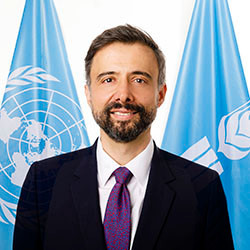IFAD Innovation Day
IFAD Asset Request Portlet
ناشر الأصول
IFAD Innovation Day
Remarks by Alvaro Lario, President of IFAD
من Alvaro Lario
موقع: Rome, Italy
28 يونيو 2023Check against delivery
Excellencies,
Distinguished guests, partners and friends
Good morning, and welcome to IFAD Innovation Day!
Today we have an opportunity to discuss how to identify, test and scale up innovations to transform the lives of poor rural people.
We desperately need new ways of thinking and doing so that agriculture and rural development are more sustainable, resilient, equitable, and inclusive.
Why? Because the world population is expected to hit 10 billion by 2050. And if nothing changes, the gap between people and available food calories is expected to be about 56 per cent1.
Climate change is already affecting farming the world over. And in the coming years, food prices might also rise. How will vulnerable rural people and small-scale producers, who are already struggling, be able to keep providing for themselves and their families while also producing food for their communities and regions?
Also, if we don’t change the course of action, it is estimated that climate change may drive nearly 2 per cent of people into extreme poverty by 2030. This is more than 100 million men and women. Many of them living in the 46 Least Developed Countries and already experiencing the negative impacts on climate change in their livelihoods.
Rural people live on the frontlines of drought, flood and other extreme weather. And yet small scale producers receive less than 2 per cent of global climate finance (2017-18).
While there is no simple answer to these challenges, it is clear to me – and to everyone here in IFAD – that innovation is part of the answer.
Let me say a few words about IFAD’s approach to innovation.
IFAD’s mandate is transforming rural economies and food systems by making them more inclusive, productive, resilient and sustainable. To that end, we invest in the millions of rural people and we embrace many kinds of innovations to deliver development impacts quicker, better and smarter.
First, we invest in idea testing.
Game-changing technology doesn’t come out of thin air. It’s the result of taking risks, allowing ideas to germinate, and then cultivating them to meet real needs in the field. That’s why IFAD provides a safe space through the Innovation Challenge.
The winning ideas of this year's Challenge, for example, reached an average of 61% women and around 2.6 thousand smallholder farmers2.
In Peru, we are testing a behavioural science toolkit to overcome barriers like gender bias.
In Sudan, an app called DiGiClimate Risk is helping development partners and rural producers to manage climate risk so they can take better decisions and make more resilient investments.
And in the Philippines, the “Land Monitor” tool is generating land tenure data by women, with women, and for women.
Second, we support corporate innovation.
Innovation is not limited to delivering results in the field. IFAD also invests in improving our efficiency and effectiveness through cutting edge tools.
For example, the Geo Scan database. It provides accurate and timely geospatial data for evidence-based decision making.
Or the Omnidata, that is a new platform that provides seamless access to data and analytics within IFAD and provides timely information for better decision making.
Apart from our own investments in innovation, IFAD also engages in co-funding opportunities. In fact, we believe it’s essential to work with partners to develop knowledge and expertise.
To that end, we collaborate with other institutions and agencies under the “Moonshots for Development” alliance. And we also work with counterparts in the private sector such as the European Institute for Innovation and Sustainability.
Last but not least, we are building a culture of innovation inside IFAD. Our new innovation labs encourage staff to ask tough questions about our processes and systems. And if they have ideas for improvement, we want to hear them.
We are also rolling out the IFAD Innovation Talks and the IFAD Innovation Network. These will provide excellent opportunities to scale up good practices.
Ladies and gentlemen,
We have an exciting day planned.
I wish you an insightful, fruitful and stimulating day.
Thank you so much for joining us.
1WRI, “Creating a sustainable Food Future”, P. 17: The 56% figure relies on assumptions such as no food loss and waste and the inclusion of animal feed. However, the publication also shows different scenarios how this figure is affected taking into account a reduction of food lost and waste – e.g. through breakthrough technologies a 50% reduction in food lost and waste would lead to a reduction of the food gap to 44% (P. 62).
2Aggregate of quantitative results data that were provided by the Innovation Teams Projects.
